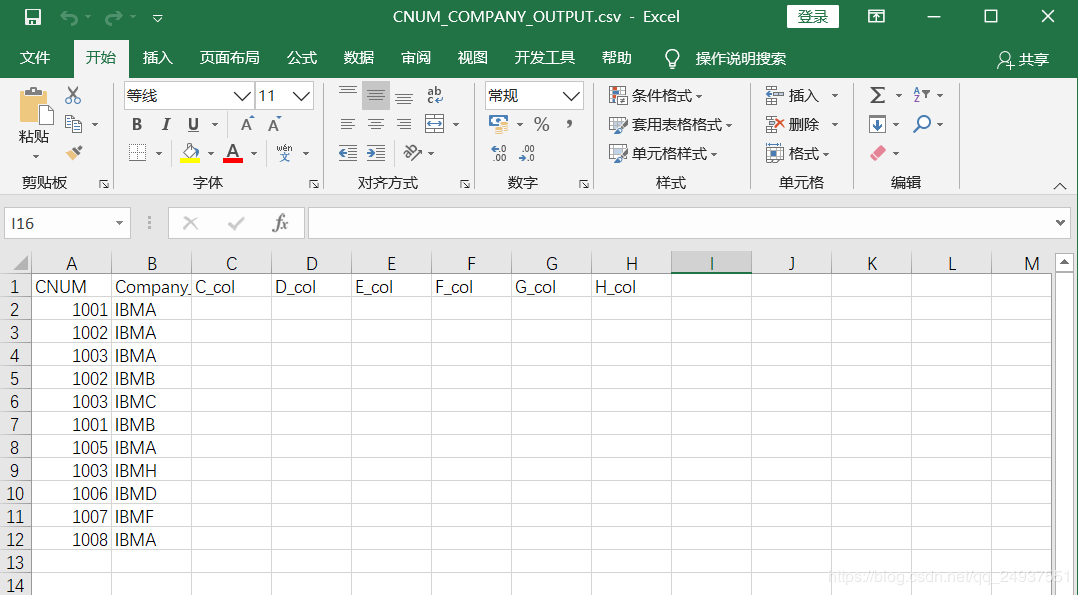需求:
現(xiàn)有一個 csv文件,包含'CNUM'和'COMPANY'兩列,數(shù)據(jù)里包含空行,且有內(nèi)容重復的行數(shù)據(jù)。
要求:
1)去掉空行;
2)重復行數(shù)據(jù)只保留一行有效數(shù)據(jù);
3)修改'COMPANY'列的名稱為'Company_New‘;
4)并在其后增加六列,分別為'C_col',‘D_col',‘E_col',‘F_col',‘G_col',‘H_col'。

一,使用 Python Pandas來處理:
|
1
2
3
4
5
6
7
8
9
10
11
12
13
14
15
16
17
18
19
|
import pandas as pdimport numpy as npfrom pandas import DataFrame,Seriesdef deal_with_data(filepath,newpath): file_obj=open(filepath) df=pd.read_csv(file_obj) # 讀取csv文件,創(chuàng)建 DataFrame df=df.reindex(columns=['CNUM','COMPANY','C_col','D_col','E_col','F_col','G_col','H_col'],fill_value=None) # 重新指定列索引 df.rename(columns={'COMPANY':'Company_New'}, inplace = True) # 修改列名 df=df.dropna(axis=0,how='all') # 去除 NAN 即文件中的空行 df['CNUM'] = df['CNUM'].astype('int32') # 將 CNUM 列的數(shù)據(jù)類型指定為 int32 df = df.drop_duplicates(subset=['CNUM', 'Company_New'], keep='first') # 去除重復行 df.to_csv(newpath,index=False,encoding='GBK') file_obj.close() if __name__=='__main__': file_path=r'C:UsersP78DesktoppythonCNUM_COMPANY.csv' file_save_path=r'C:UsersP78DesktoppythonCNUM_COMPANY_OUTPUT.csv' deal_with_data(file_path,file_save_path) |
二,使用 VBA來處理:
|
1
2
3
4
5
6
7
8
9
10
11
12
13
14
15
16
17
18
19
20
21
22
23
24
25
26
27
28
29
30
31
32
33
34
35
36
37
38
39
40
41
42
43
44
45
46
47
48
49
50
51
52
53
54
55
56
57
58
59
60
61
62
63
64
65
66
67
68
69
70
71
72
73
74
75
76
77
78
79
80
81
82
83
84
85
86
87
88
89
90
91
92
93
94
95
96
97
98
99
100
101
102
103
104
|
Option Base 1Option ExplicitSub main() On Error GoTo error_handling Dim wb As Workbook Dim wb_out As Workbook Dim sht As Worksheet Dim sht_out As Worksheet Dim rng As Range Dim usedrows As Byte Dim usedrows_out As Byte Dim dict_cnum_company As Object Dim str_file_path As String Dim str_new_file_path As String 'assign values to variables: str_file_path = "C:UsersP78DesktopPythonCNUM_COMPANY.csv" str_new_file_path = "C:UsersP78DesktopPythonCNUM_COMPANY_OUTPUT.csv" Set wb = checkAndAttachWorkbook(str_file_path) Set sht = wb.Worksheets("CNUM_COMPANY") Set wb_out = Workbooks.Add wb_out.SaveAs str_new_file_path, xlCSV 'create a csv file Set sht_out = wb_out.Worksheets("CNUM_COMPANY_OUTPUT") Set dict_cnum_company = CreateObject("Scripting.Dictionary") usedrows = WorksheetFunction.Max(getLastValidRow(sht, "A"), getLastValidRow(sht, "B")) 'rename the header 'COMPANY' to 'Company_New',remove blank & duplicate lines/rows. Dim cnum_company As String cnum_company = "" For Each rng In sht.Range("A1", "A" & usedrows) If VBA.Trim(rng.Offset(0, 1).Value) = "COMPANY" Then rng.Offset(0, 1).Value = "Company_New" End If cnum_company = rng.Value & "-" & rng.Offset(0, 1).Value If VBA.Trim(cnum_company) <> "-" And Not dict_cnum_company.Exists(rng.Value & "-" & rng.Offset(0, 1).Value) Then dict_cnum_company.Add rng.Value & "-" & rng.Offset(0, 1).Value, "" End If Next rng 'loop the keys of dict split the keyes by '-' into cnum array and company array. Dim index_dict As Byte Dim arr_cnum() Dim arr_Company() For index_dict = 0 To UBound(dict_cnum_company.keys) ReDim Preserve arr_cnum(1 To UBound(dict_cnum_company.keys) + 1) ReDim Preserve arr_Company(1 To UBound(dict_cnum_company.keys) + 1) arr_cnum(index_dict + 1) = Split(dict_cnum_company.keys()(index_dict), "-")(0) arr_Company(index_dict + 1) = Split(dict_cnum_company.keys()(index_dict), "-")(1) Debug.Print index_dict Next 'assigns the value of the arrays to the celles. sht_out.Range("A1", "A" & UBound(arr_cnum)) = Application.WorksheetFunction.Transpose(arr_cnum) sht_out.Range("B1", "B" & UBound(arr_Company)) = Application.WorksheetFunction.Transpose(arr_Company) 'add 6 columns to output csv file: Dim arr_columns() As Variant arr_columns = Array("C_col", "D_col", "E_col", "F_col", "G_col", "H_col") ' sht_out.Range("C1:H1") = arr_columns Call checkAndCloseWorkbook(str_file_path, False) Call checkAndCloseWorkbook(str_new_file_path, True)Exit Suberror_handling: Call checkAndCloseWorkbook(str_file_path, False) Call checkAndCloseWorkbook(str_new_file_path, False)End Sub' 輔助函數(shù):'Get last row of Column N in a WorksheetFunction getLastValidRow(in_ws As Worksheet, in_col As String) getLastValidRow = in_ws.Cells(in_ws.Rows.count, in_col).End(xlUp).RowEnd FunctionFunction checkAndAttachWorkbook(in_wb_path As String) As Workbook Dim wb As Workbook Dim mywb As String mywb = in_wb_path For Each wb In Workbooks If LCase(wb.FullName) = LCase(mywb) Then Set checkAndAttachWorkbook = wb Exit Function End If Next Set wb = Workbooks.Open(in_wb_path, UpdateLinks:=0) Set checkAndAttachWorkbook = wbEnd Function Function checkAndCloseWorkbook(in_wb_path As String, in_saved As Boolean) Dim wb As Workbook Dim mywb As String mywb = in_wb_path For Each wb In Workbooks If LCase(wb.FullName) = LCase(mywb) Then wb.Close savechanges:=in_saved Exit Function End If NextEnd Function |
三,輸出結果:

兩種方法輸出結果相同:
四,比較總結:
Python pandas 內(nèi)置了大量處理數(shù)據(jù)的方法,我們不需要重復造輪子,用起來很方便,代碼簡潔的多。
Excel VBA 處理這個需求,使用了 數(shù)組,字典等數(shù)據(jù)結構(實際需求中,數(shù)據(jù)量往往很大,所以一些地方?jīng)]有直接使用遍歷單元格的方法),以及處理字符串,數(shù)組和字典的很多方法,對文件的操作也很復雜,一旦出錯,調試起來比python也較困難,代碼已經(jīng)盡量優(yōu)化,但還是遠比 Python要多。
到此這篇關于VBA處理數(shù)據(jù)與Python Pandas處理數(shù)據(jù)案例比較分析的文章就介紹到這了,更多相關VBA與Python Pandas處理數(shù)據(jù)內(nèi)容請搜索服務器之家以前的文章或繼續(xù)瀏覽下面的相關文章希望大家以后多多支持服務器之家!
原文鏈接:https://blog.csdn.net/qq_24937551/article/details/105338086





